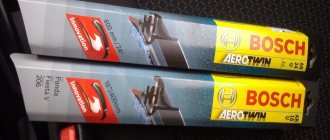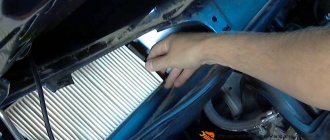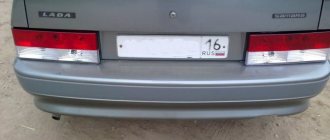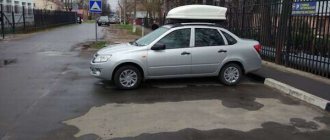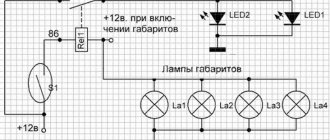The relative simplicity of the Lada Granta’s design, including the liftback, allows for a number of preventive and repair work to be carried out outside the service center. Even during the warranty period, the manufacturer allows basic work to be carried out outside of an official service station.
For example:
- replenishment of cooling system fluid and engine oil;
- replacing windshield wiper blades;
- replacement of light bulbs, front and rear optics.
Necessary tool for flashlight replacement
So, how to remove the rear light on a liftback: for these purposes you will need time, tools, a platform (platform), and a set of new consumables.
- A set of automotive tools, in particular: a flat-tip screwdriver, an “8” socket, a socket wrench of the same size;
- Rags, liquid for removing rust and corrosion WD - 40;
- New optics;
- Lighting lamps if necessary.
Replacement algorithm
- We turn off the engine, squeeze the handbrake;
- Open the back door;
- Depending on the model year, the sequence of actions differs. In the first generation (until 2015), unfasten the casing flap and provide free access to the back of the optics. In the second generation, remove the plastic latch, remove the lamps, unscrew the three nuts.
We replace the reflector, lamps, and assemble the structure in the reverse order.
Catalog articles for lighting lamps in Granta Liftback rear lights
| Name | OEM number / index / article |
| Turn signals | PY21W |
| Brake/side light | P21 |
| Anti-fog headlight | P21W |
| Reverse | P21W |
| License plate | С5W |
| Luggage compartment | С5W |
| Salon | С10W |
Related link:
Review of the Granta Liftback trunk. Dimensions in centimeters
Features of replacing the tail light of the Lada Granta liftback
After unscrewing the three nuts, remove the Grant liftback tail light from the guide grooves. This must be done carefully, without jerking and strictly straight. Otherwise, you risk damaging the plastic latch on the case.
The design is too fragile, careless handling can lead to damage. If the guide is deformed, reuse of the flashlight is no longer possible due to the lack of a lock.
Replacing the Grant liftback fog lamp in the front part is carried out by analogy. Work is carried out from the rear of the bumper.
The nuances of installing LED DRL lamps
If there are no baseless LED lamps for the Lada Grant, you can install ordinary base lamps. In this case, you will have to remove the base from the diode yourself, and fit the free antennae to the mounting holes.
After replacing the lamps, do not throw away the old halogen devices. The fact is that in order to comply with regulatory and technical requirements for daylight, after installing new lamps, you will need to visit a technical center. Otherwise, the next scheduled technical inspection will prohibit the operation of a car with such modified headlights.
Elements of tuning optical devices
Recently, installation of LEDs has become popular. There are many advantages with analogues: long service life, direction of the light beam, brightness, resistance to high plus and minus temperatures.
And the main trump card is cost, availability, and a wide range of color shades.
The installation process is somewhat different from the usual, as it is necessary:
- dismantle the standard illuminator (lamp);
- depressurize the lantern, remove the rubber seal;
- cover the seat with LED strip of the required length;
- connect the contact board;
- Reassemble the structure in reverse order.
Recently, it has become popular to install fog lights on the rear bumper. This improves visibility when passing backwards and prevents accidents. Replacing the rear fog light of a Lada Granta liftback is carried out by analogy.
Reasons for the burnout of the brake light lamp on Grant
There can be many reasons for the frequent burnout of brake light bulbs on the Lada Granta, here are the most common ones:
- Limited resource. Light bulbs from many manufacturers do not withstand constant use. Replacing standard lamps with cheap Chinese analogues makes itself felt.
- Moisture getting inside the headlights. This occurs due to cracked or poorly fitting rubber seals. They are located between the body and the glass. This problem is easy to diagnose: the headlight regularly fogs up from the inside. This can also be verified by inspection.
- Incorrect installation. Halogen headlights suffer if basic installation rules are not followed. For example, inexperienced car owners begin to install lamps with their bare hands, which is prohibited: the presence of greasy marks reduces their service life.
- Incorrectly selected power. It is not recommended to install 100-watt lamps. You need to take less power, but increased brightness. This will significantly improve visibility and extend the life of the device.
- Defective light bulbs. The low beam lamp often burns out when there are significant flaws made during assembly.
- The flask tilts, the spiral moves off its axis. All this negatively affects performance.
- Battery low. This happens when the unit gets old and begins to discharge quickly. Charging requires high currents, so the vehicle's on-board network suffers from overvoltage. This situation requires diagnosis by an experienced auto electrician.
- Wiring problems. It can be damaged as a result of the carelessness of the car owner himself. You need to check the wiring if the car has a new owner. Understanding electrical wiring on your own is quite difficult.
- Any malfunction of the on-board electrical network can cause failure of not only the light bulb, but also other electrical appliances.
- Poor quality lamp. There are many unscrupulous manufacturers offering headlight bulbs with minimal working life.
If your rear brake lights stop working, you should not rush to extremes and run to an auto electrician; in most cases, the problem is solved by replacing the lamps.
Typical signs of a lighting system malfunction
- lack of indication on the dashboard when the turn signals, high/low beam lever, and brake light are activated;
- frequent indication of the above indicators;
- the high/low beam lever does not activate the lamps;
- insufficient brightness of lamps and flashlight reflector.
The above signs indicate damage, deformation, or a break in the electrical circuit of the lighting system. To troubleshoot problems, you will need comprehensive diagnostics, identification of the breakdown, and subsequent replacement of elements. You can do this either independently or by contacting a service center for help from specialists.
Is it worth replacing a working running light bulb?
But such lamps have more than enough disadvantages!
- Including dim light with a yellow tint, which does not have the best effect on visibility in front of the car.
All this forces people to change the running light bulbs in their cars almost immediately after purchase.
LED DRL lamp is more practical and brighter
In principle, replacement may also apply to new incandescent lamps if the old ones fail. But, nothing prevents you from using LED lamps. Pay attention only to the base, which must correspond to the connector that is supposed to be in the car.
Analysis of reviews from Lada Granta liftback owners
- Grant-Eject (https://www.drive2.ru/l/6512513/): the sedan's lamps are different from those of the liftback. In the first modification they are combined, in the liftback they are separate.
- Diyk: taillights often sweat on sedans, the problem has been eliminated in the liftback;
- Silica Gel: to quickly remove moisture, attach a moisture absorber for shoes to double-sided tape. It doesn't last long, but it's effective. Improving the sealing of the rear lights is an alternative option.
- Grant-Eject: insufficient fixation contributed to the flashlight falling out during movement.
- LADA Granta 2012 (https://www.zr.ru/content/articles/832528-lampy-primenyaemye-v-avtomobile-lada-granta/): the car is reliable, unpretentious, subject to a moderate driving style. Over a period of five years of operation, breakdowns are typical and characteristic.
Related link:
Updated Granta Liftback 2022. Better or worse
Summing up
A reverse light that doesn't come on is just as potentially dangerous a problem as a reverse light that stays on all the time, even when the car is moving forward.
Therefore, such a problem cannot be ignored under any circumstances. Just like installing a flashing brake light for the sake of beauty. It may look impressive, but it confuses drivers significantly.
In some cases, you can find and eliminate the cause yourself. And without any problems. But there are also situations when the best solution is to visit an experienced auto electrician.
I have a Granta liftback and at some point both lights stopped coming on when I engaged reverse gear.
It is too stupid to think about burnt out lights, 2 lights cannot burn out at the same time, which means there may be a fuse or a reverse sensor on the gearbox.
I recommend starting diagnostics with the fuse:
Fuse F6 is responsible for the reversing lights. Pull the fuse and see if it's blown? I think it's unlikely to burn out. But it's worth checking.
If the fuse is intact, then the problem may be with the sensor. But this can also be checked.
First, the sensor on the 2181 box (cable box) is located above it, unlike the old box, where the sensor was below.
The sensor is located directly above the box. If you look at the box under the hood, you will see it. There are no options here.
Secondly, we remove the chip from the sensor and close the contacts with a regular paper clip:
Next, turn the ignition key and go look at the rear lights. No need to engage reverse gear
Are you on fire? That's it, it means the problem is in the sensor, which means it needs to be changed.
To replace the sensor, we need the sensor itself and a key for 22. I had this regular key:
And of course you need the sensor itself:
Sensor marking: 2190-3710410. In the photo above is the original sensor that was installed on the 2014 Lada Granta liftback from the factory.
I go to the store and buy such a sensor with the inscription “OTK” for 85 rubles. Thanks to VAZ for the fact that all these sensors are available in any store and you don’t have to wait weeks for delivery.
Installing the sensor is simple: unscrew the old sensor, screw in the new one, and put the chip in place. There is a copper ring under the sensor, don't lose it.
Do I need to remove the air filter? Everything depends on you. I was able to reach right under the filter with my hands and rip off the sensor. Why rip it off? Because it is very twisted, be prepared for it.
Reversing at night will be a real challenge if the car's reverse lights are not on. Let's look at why the lamps stopped burning and methods for independently searching for the root causes. Most likely, knowing how to test the reverse light switch will be the most useful skill when troubleshooting.
Check list
- Turn off the engine, squeeze the parking brake lever;
- Open the liftback cover;
- Remove the plastic protection / sound insulation layer. The choice depends on the model year. More details are described at the beginning of the article;
- Unscrew the lamps, three nuts;
- Replacement of Grant liftback taillight lamps, carry out related preventive maintenance;
- Reassemble the structure in reverse order.
Conclusion based on the results of the replacement The design and fixation of optical devices is not at all complicated. Every car owner can do the replacement; there is no need to contact a service center. Only as a last resort, when a global breakdown is identified or surgical intervention by a specialist is required. After reading the instructions provided, the owner knows exactly how to change the Granta liftback taillight with minimal time.
Place of the switch in the light switching circuit
On cars with manual transmission, voltage to the lamps when reversing is supplied through a limit switch (the so-called frog), which is screwed directly into the gearbox housing. When reverse gear is engaged, the switch button is pressed inside the gearbox. The contacts inside the “frog” bridge, and current begins to flow to the lamps.
On the circuit diagram for turning on the reversing lights, we can see that on the VAZ 1118 Kalina, the current from the battery through the ignition switch (No. 2) is supplied to fuse F1. Passing through the fuse that protects the switching circuit, “+” goes to the limit switch (No. 10). The contacts are in a normally open state and close only when reverse gear is engaged. Thus, current begins to flow to the light bulbs. The second contact of the lamps is connected to the “–” battery through the common ground contact of the lamps.
On cars with automatic transmission, the role of the limit switch lies with the selector position sensor. Information about changing the location of the gearshift knob is transmitted to the engine ECU, the light control unit.
How to check the "frog"
- Remove the headlight switch chip.
- Turn on the ignition.
- Using a small piece of wire, connect the contacts of the reverse gear sensor connector to each other.
If the reverse lights are on, then the problem is in the “frog”. Some drivers disassemble the switches, clean the contacts, after which the device continues to work properly. It is up to you to judge the appropriateness of such measures. But keep in mind that on many cars (including VAZ models) the limit switch is located below the oil level in the gearbox. We recommend simply replacing the power sensor. To minimize oil loss, jack up the car on the side where the end switch is installed.
On some cars, the reversing lights do not light up due to incomplete activation of the limit switch. The problem can be solved by installing a thinner washer under the “frog”. To make sure that the switch is working, check with a multimeter in ohmmeter mode whether the contacts close when you press the button.
Checking the circuit
The essence of diagnosing the reason why the reverse lights do not work comes down to identifying the section of the circuit where the voltage is lost. To do this, you can use a regular control light. Continuity testing is done with an ohmmeter, so you need to know how to use a multimeter.
You can start checking directly from the limit switch connector. Turn on the ignition. Connect one contact of the control light to an unpainted metal part in contact with the body, and the second to the “+” connector.
- If power comes in, check the reverse sensor.
- If after installing the “jumper” in the connector the lights do not light up, then the problem is in the section of the wire circuit going from the connector to the lights. Ring the wire to the point where it divides into light bulbs on the left and right sides. Most likely, the reason is the break.
To find the pinout of connectors, light contacts, and wire colors, be sure to study the electrical diagram of your model and vehicle configuration.
The lamps are constantly on
If the lights on your car are constantly on or come on regardless of whether reverse gear is engaged, the cause will be among the following breakdowns:
- short-circuiting the “+” going to the reverse gear sensor and the light bulb wires from the switch;
- the wire going from the connector to the lights has a short to “+” (this happens if the wires in the harness fray);
- The sensor is stuck in a closed state.
Malfunction of reverse lights on VAZ 2114. Maintenance and prevention
Reversing lights for VAZ 2114
What are reverse lights? These are white road lights that turn on in reverse gear, guaranteeing safety while driving. If the reverse lights are not on, then the possibility of the driver getting into an emergency increases; it is very difficult to park in the dark when the road is not visible, and passengers will not be able to predict the actions of vehicles, which can lead to unpleasant consequences.
The frog signal device is a necessary device. As they say “in the language of a motorist”: everything that is in the car must function properly, the safety of vehicle traffic depends on it!
So, at the slightest breakdown or short circuit of the reverse light, you need to immediately begin repairing it. This can be done both at service stations and at home, quickly and very simply. And this theoretical basis will be a great help!


